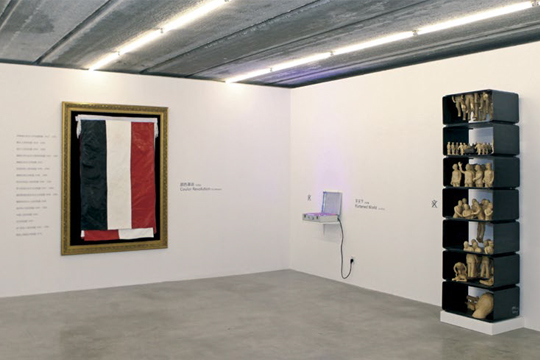PESSIMISM OR RESISTANCE?
| July 22, 2013 | Post In LEAP 21

Courtesy of Taikang Space
This Su Wenxiang-curated exhibition possesses a title that immediately conjures an atmosphere of political opposition. Yet the title seems dissociated from the exhibition itself, lingering instead by the gallery entrance, or drifting like a soft cloud above the visitor’s head. During its travels between the mouths of its visitors, it is soon simplified into an even more vague and gimmicky catchphrase, “a group exhibition of 27 artists about politics.” Soon after entering Taikang Space, visitors find themselves amidst five groups named according to “topics” by Su.
Kicking off with “Spiritual Axis” and “Great Portraiture,” the curator, taking on the inertia left behind by the discursive architects of the generation previous to him, adopts two signifiers to act as entry points for political motives. Relying on “correct political correctness,” they establish a stimulating-yet-safe first impression, simultaneously swallowing up the third topic “The Everyday and the Collective,” located on the same floor. “Rehearsal” and “Local Affiliation and International Imagination,” located on the second and third floors respectively, instead deal with traversal of space, and provide opportunity for constructive thinking and a fresh mindset, to shake off oppressive modes of thinking.
A total of 30 artworks feature in the exhibition, and span a 25-year period (1988-2013), this scale thus ambiguously contributes to the ongoing trend of “chronological,” history-writing exhibitions, which began in 2010 with “Reshaping History” and continued with “Thirty Years of Chinese Contemporary Art: 1979-2009” (2010) and “Moving Image in China: 1988-2011” (2011), both at Minsheng Art Museum. As well as the works on display, a further set can be viewed on visitors’ smartphones via a complicated set of QR codes somewhat confusingly dispersed across the walls, providing further proof of the lofty ambition, or wild careerism, that lies behind this show. Fortunately, the topics and their accompanying texts avoid dialectical and logical parallels, and furthermore attempt to restrain the sentimentalism of their titles, instead opting for objective plainness and brief historical narrations. The small size of Taikang both rigidly stifles the aspirations of the artists and curator, and also confines the political fervor of the works to the small spaces they occupy. Such conditions effectively allow the viewer leeway to consider each piece independently in a cool-headed fashion, while further source material helps trigger discussion, extend potential, and facilitate striking contrasts—such as Jiang Zhi’s video of third-generation Communist leaders locked in a perpetual act of jogging alongside Wang Guangyi’s “composite” paintings.
However, after surveying the exhibition as a whole, it becomes clear that the relationships between factors inherent to the works—the generation they belong to, the artists’ intentions, experience, and knowledge composition—transcends and even consumes the five “topics” they are confined within. In the case of the first four in particular, works of different generations and systems made by different individuals who employ personal or local political motifs have been brought together. Their many subtleties and inferences counteract, while the uniform inference bestowed upon them (i.e. their “topic”) is by its ubiquitous presence constantly magnified. In these artworks, “politics” acts as a kind of motive; the artists perform their criticisms against central power and pedigree from a safe distance. They certainly do not possess the capabilities to bring about change to the system or society. Instead, romanticism is granted an easy “win-win situation.” In one sense, the above rebuts the political symbols that represent the totems and their adherence to system taboos. In another, the stable political situation safeguards the validity of the works’ critiques. In the case of the fifth topic, “Rehearsal,” the artists’ flirtations with international politics are full of imagination, yet pass as nothing more than self amusement isolated within a marked geographical and linguistic context, thus existing as little more than a faint echo outside of it.
In conclusion, the intrinsic nature of these works topples the many titles and topics of this exhibition one by one, but due to the works’ collective failing to confront issues directly, as well as the “safe distance” they share, one of the exhibition’s topics is accidentally highlighted, even magnified: the exhibition becomes a set of endlessly staged “Rehearsals.”


